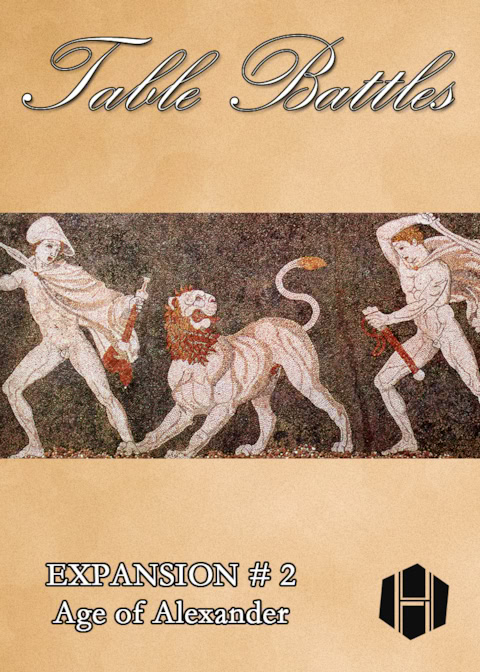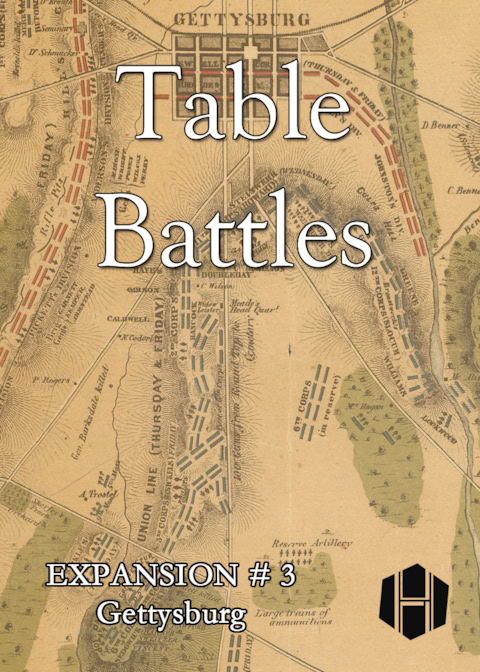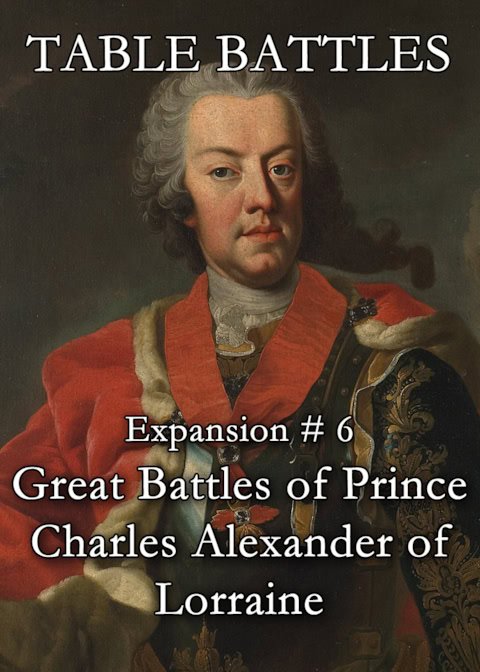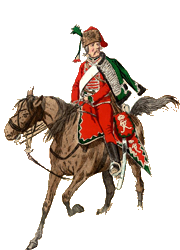

❦ Designed by Amabel Holland ❦
The goal of Table Battles is to provide light but crunchy two-player gaming experiences out of land battles fought throughout human history. These aren't detailed simulations, but quick fillers that should play out in about fifteen or twenty minutes. Many of these battles are difficult to game in a more conventional hex-and-counter format because they are largely static. Indeed, the game has no maneuver element at all. Instead, the decision space is dominated by feints and counter-feints, the threat of force, its application, and its neutralization. Good play is about leverage and tempo, about forcing the other person to deal with what you're doing, instead of advancing their own aims.
Your copy of the game should come with twelve dice (six for each player), a deck of 50 cards, eighty wooden Units (20 sticks each in four colors), and ten wooden cubes.
The dice are used to commit to, and execute, actions.
The cards represent Formations, and dictate what those Formations can do.
The Units represent the strength of those Formations.
The cubes are used to represent Morale, and also the capabilities of Special Formations.
The Formation Cards are really the core of the game. Let's look at one, shall we?

The color band behind the name indicates the Wing to which it belongs; for example, this Formation belongs to the Red Wing.
This is the number of wooden Units that the Formation has assigned to it at the beginning of the battle.
This indicates the type of dice that can be placed on a card.
This indicates what the Formation can do when there are dice on the card.
Indicates the card number information, which is used in set-up. Each card has an "A" and a "B" side.
Each scenario has a set-up card.
The set-up card will list the sides and who goes first. The Formation Cards for each side will be indicated; each player should place their cards in front of themselves.
For all normal Formations, place wooden Units of its Wing's color, equal to the Strength of the Formation, in front of the Formation Card. Single-wing armies may need to use pieces of a second color (e.g., the White Mountain scenario).
For all Special Formations, place one wooden cube near the Formation Card (regardless of the Strength indicated).
The set-up card will indicate the starting Morale for each side. Each player should take that many cubes, designated as Morale Cubes, and place them to the side of their army.
Finally, each player takes six dice, forming their own Dice Pool, and play begins with the first player's turn.
The set-up card or one or more of the Formation Cards may have a special rule. As is usually the case with these sorts of things, when the special rule contradicts these rules, follow the special rule.
You can win the game in one of two ways:
By reducing your opponent's Morale, measured in Morale Cubes, to zero.
By Routing sufficient enemy Formations that, at the beginning of your opponent's turn, it is impossible for any of their remaining Formations to ever Attack any of your Formations. It doesn't matter if you also can't Attack any of their - the check is made at the beginning of a player's own turn, and the first player to fail this check loses the game.
The game is played in alternating Player Turns until one side wins. A Player Turn consists of two phases, always performed in this order: an Action Phase, and a Roll Phase. When a player has finished their Roll Phase, proceed to their opponent's Action Phase. A player's Action Phase is skipped if they performed a Reaction during their opponent's Action Phase. This is a crucial rule, so we'll say it again, and heck, we'll even bold it for emphasis: A player's Action Phase is skipped if they performed a Reaction during their opponent's Action Phase.
During the Action Phase, the acting player may (but is not required to) take one Action with one Formation. If this Action triggers a Reaction from an opponent's formation, then that one Reaction takes place during that same Action Phase.
To take an Action (or a Reaction) with a normal Formation, you must remove all dice currently on the Formation Card, and you must meet the stated Requirement for the Action (if any).
The Actions are as follows:
The core Action of the game. This allows you to attack the stated enemy Formation, inflicting Hits.
This Action is usually restricted to a Special Formation. It causes the removal of one Morale Cube from your opponent. It cannot be used to remove your opponent's last Morale Cube, and cannot be Screened.
This Action causes a named Formation that is in Reserve to become active.
The Reactions are as follows:
This cancels an Attack from an enemy Formation which is listed as a target of the Screen. (Unlike with an Attack, all listed Targets may be Screened regardless of their status.) While both sides expend their dice, neither side suffers any losses.
When the Formation is Attacked, a Counterattack causes the enemy Formation to sustain Hits as indicated in the Action text. Hits are applied simultaneously to both sides.
When a friendly Formation listed as a Target suffers Hits, this Formation may suffer the Hits instead. Note that as this is a Reaction, it may only be performed during your opponent's Turn.
Again, Reactions are mandatory unless the Action text specifically indicates that it is Voluntary. If you take a Reaction during your opponent's Action Phase, you get no Action Phase on your own subsequent Player Turn.
During the Action Phase, instead of taking a standard Action, a Formation that has "RETIRE" on its card may Retire, leaving the game.
Some Formations begin in Reserve, and have another friendly Formation's name listed in the Reserve section.
When a Formation takes Hits, its wooden Unit pieces are removed. When it has no Unit pieces left, the Formation Routs. Formations that Rout are removed from the game. When a Formation Routs, that side gives one of its Morale Cubes to the other player; if the Formation was marked with a star, it gives two Morale Cubes to the other player.
If friendly and enemy Formations Rout simultaneously, no Morale Cubes are given to either player, even if one of those Formations was marked with a star.
If a Routing Formation had dice on its Formation Card, the dice are returned to the owning player's Dice Pool.
Some Formations must perform Pursuit when an enemy Formation that is the Target of their Attacks is Routed. Pursuit is performed automatically at the instance of the Routing, and results in the Pursuing Formation being removed from play. This is not considered Routing and does not alter Morale for the Pursuing side. If the Pursuing Formation had dice on its Formation Card, the dice are returned to the owning player's Dice Pool.
During a player's Roll Phase, they take all the dice from their Dice Pool and roll them. Dice that are currently on a Formation Card are not in the Dice Pool.
After making their roll, the player may (but is not required to) place dice on one Formation Card per Wing. For example, if a player has only Red Wing Formations, they may place dice on only one Formation Card, total. If a player has both Red Wing and Pink Wing Formations, they may place dice on one Red Formation and on one Pink Formation, for a total of two Formation Cards. Placing dice of a type on one Wing's Card does not preclude you from placing dice of the same type on your second Wing's Card. For example, if Tom's Division (Red Wing) and Mary's Division (Pink Wing) can only accept sixes, you can place some sixes on Tom's Division and some on Mary's, provided of course that you rolled them.
Dice may only be placed according to the information on the Formation Card's Dice Area. Dice remain on the Card until the Formation takes an Action, or until it Routs or performs Pursuit.
Special Formations act somewhat differently from normal Formations. They cannot be Attacked, and if removed from play, they do not alter Morale.
When dice are "placed" on a Special Formation Card, a wooden cube is placed on or near the card instead, and the dice are immediately returned to the Dice Pool.
When a Special Formation takes an Action or Reaction, it expends one (and only one) of the wooden cubes assigned to its card.
Special Formations always begin the battle with one cube assigned to them. The Strength on the Special Formation's card indicates the maximum number of cubes that can be assigned to the card.
Edge case: If all ten cubes are in play, either as Morale Cubes or on Special Formations, a cube cannot be placed; Morale Cubes removed from the game become available for use for Special Formations upon doing so.
Special Formations generally represent massed artillery or inspired leadership.
Design: Amabel Holland
Rules Editing: Mary Holland-Russell, Travis D. Hill
Layout: Mary Holland-Russell
The designer wishes to gratefully acknowledge her intellectual debt to Hanno Uusitalo, Kim Paqvalin, and Edwin S. Lowe.
❦

This expansion contains Scenarios 9 through 16. In addition to the eight Scenario cards and the card you're holding in your hand, this set includes 40 new Formation Cards. Because these battles are all drawn from one conflict, you will see the same characters pop up repeatedly; it's important to utilize the card number to ensure you have the correct Formation for that specific scenario.

This expansion contains Scenarios 17 through 23 and Formation Cards 92 through 135. As always, make sure you're using the cards specific to that scenario as many cards have similar names.
Alexander won every battle he fought thanks to the many advantages of the Macedonian system. His enemies were hopelessly outmatched. The onus is on the Alexander player to win decisively; the other player often only needs to Rout one of Alexander's formations to win the game.

This expansion contains Scenarios 24 through 29 and Formation Cards 136 through 177.
These scenarios are drawn from the second day of the Battle of Gettysburg; the first five scenarios cover some of the most famous engagements largely at regimental and brigade scales, while the sixth zooms out to cover the whole day at a larger scale. Neat, huh?
What's this? Another card?
Well, after the title card, the scenario cards, and the formation cards, we're up to forty-nine, and we really need fifty in a deck to get the best price. So we need one more, and here we are.
While we're here, I'd like to take a moment to thank some folks. First up is Steve Carey and Rodger MacGowan for making the C3i magazine expansion possible (if you want to know where Formation Cards 83 - 91 went, that's where).
Second is Rick Barber, Gettysburg resident and map artist extraordinaire, who let me pick his brain while I designed this expansion.
Third is Mary, who is probably disappointed by the lack of dinosaurs this time around. Soon.

This expansion contains Scenarios 30 through 35 and Formation Cards 178 through 216. This expansion also includes four replacement cards for Expansion 3, to correct some minor errors from the first printing. Fare-thee-well, Wilcow; we hardly moo ye.
In some scenarios, a player that eliminates a certain number of enemy unit sticks achieves a Tactical Victory. When this applies it will be indicated for that side on the scenario card, with the target number. Sticks removed due to Retirement or Pursuit do not count toward the target number.

This is the fifth expansion to Table Battle. This time around we're looking at some battles fought by the Grand Alliance - the Dutch Republic, England, Austria, and sometimes Spain and Savoy - against France (and sometimes Spain and Savoy) during the Nine Years War and the War of the Spanish Succession (which was the first of several wars of succession fought in succession).
Specifically this set encompasses Scenarios 38 - 43, and Formation cards 226 - 263. Some scenarios will utilize the Tactical Victory rule that was introduced in Expansion #4: a player that Eliminates a certain number of enemy unit sticks achieves a Tactical Victory (or in some cases, a Draw). Sticks removed due to Retirement or Pursuit do not count toward the target number. Normal victory by the opponent supercedes a Tactical Victory or Draw.
You might be curious what the heck that square with the two bars is on these two explanation cards, and why they also appear on some of the formation cards. This is called a Link; cards with successive ID numbers with paired Link symbols (for example, 233-A and 234-A) are Linked Formations. So long as a card shares a Link with at least one other card, it suffers one less Hit when it is Attacked. Once it no longer shares any Links, it suffers Hits normally. If a card Absorbs Hits, the presence of a Link - either on its own card or the original target's - does not reduce the number of Hits inflicted.
Lastly, I wish to thank Doug Miller, whose library, expertise, and friendship proved invaluable.

Over the course of a decades-long career, Charles Alexander, Prince of Lorraine commanded Austria's forces in some of the most important, memorable, and famous battles of his age. I mean, sure, he lost all those battles while Frederick the Great and other luminaries just ran absolute circles around him, but hey, he was also there, the jobber of 18th century warfare, existing to be beaten by the main eventers.
Of course, we only say that because he lost over and over again, usually when the odds were clearly in his favor. But that didn't need to be the way his story played out...
This expansion includes six new scenarios, 44 - 49. It uses four special rules which apply to all of them.
You might be curious what those squares with the two bars is on this card, and why they also appear on some of the formation cards. This is called a Link; cards with successive ID numbers with paired Link symbols are Linked Formations.
So long as a card shares a Link with at least one other card, it suffers one less Hit when it is Attacked. Once it no longer shares any Links, it suffers Hits normally. Cards that are not yet in play (i.e., that are In Reserve) are not yet Linked!
If a card Absorbs Hits, the presence of a Link - either on its own card or the original target's - does not reduce the number of Hits inflicted.
A player that Eliminates a certain number of enemy unit sticks achieves a Tactical Victory. This is a "win", though not as impressive of course as a normal one. It's probably the best our boy Charles Lorraine can hope for though. Sticks removed due to Retirement or Pursuit do not count toward the target number. Normal victory by the opponent supercedes a Tactical Victory.
Many Formations will be either Infantry or Cavalry. This distinction is important for the purposes of the new Shift mechanism.
At the start of your turn, you may initiate a Shift of
one or more sticks from one Formation of your
choice to another, provided that
(a) both are Infantry or both are Cavalry, and
(b) you do not remove a Formation's final stick.
Place the sticks behind the Formation that is to receive them. At the start of your next turn, before initiating any other Shift, add them to that Formation. If the Formation is Routed or removed before these sticks arrive, the sticks are Eliminated.
If you initiate a Shift, your Action Phase is skipped that turn. You may still initiate a Shift if you reacted on your opponent's turn.




Before resolving hits from an Attack made by an Infantry Formation, compare its number of sticks to the number possessed by the target (or, if the Attack is Absorbed, the Absorbing Formation).
If the difference is at least three sticks, and in the Attacker's favor, the enemy suffers one extra hit.
❦